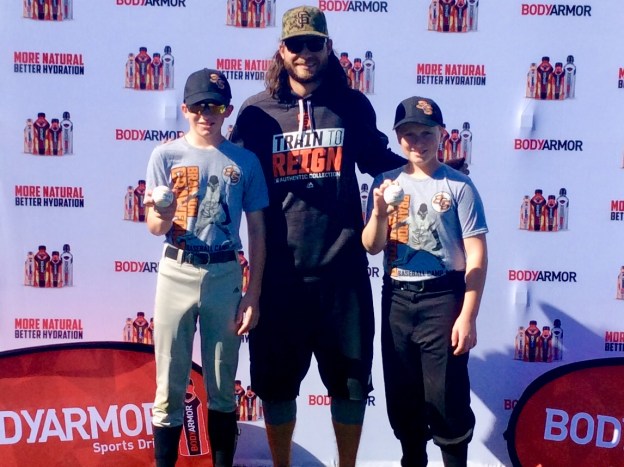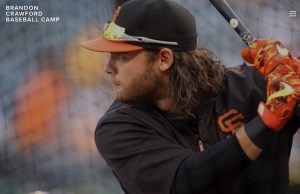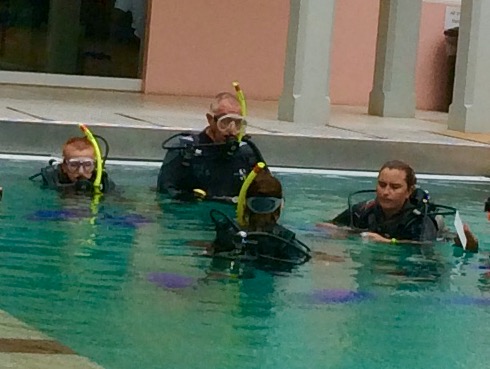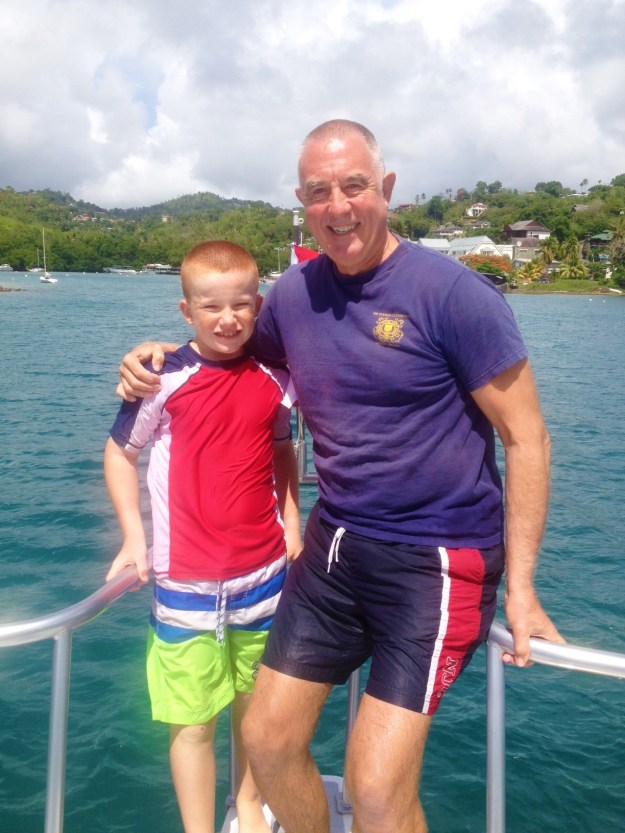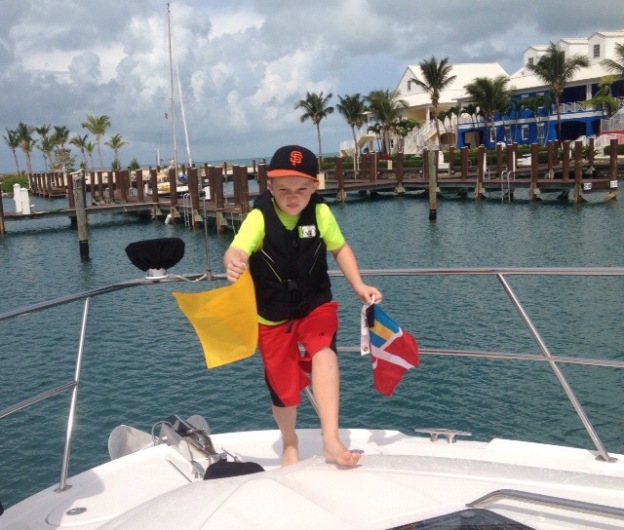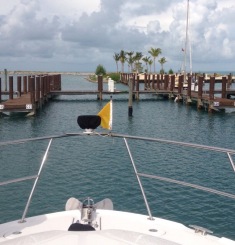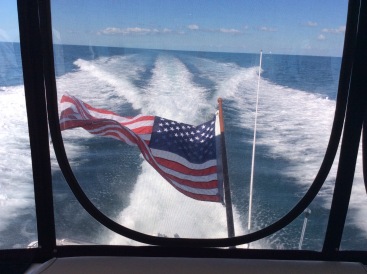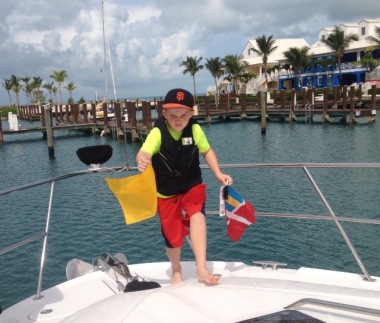For Christmas, one of the presents our mom and dad got Ryan and me was two days at “Brandon Crawford Baseball Camp!” We could not believe it! Brandon Crawford is a major league baseball player who plays short stop for the San Francisco Giants. The camp started on January 27th, so Ryan and I had a month to practice our game. Before we knew it, we were flying from St. Lucia, (the West Indies) in the Caribbean, to Phoenix, Arizona, for the baseball camp. The camp was held in Scottsdale, Arizona because that is where the Giants do their spring training. We had an overnight layover in Miami, so it took us two (2) days to get to Arizona from the Caribbean. Ryan & Ronan outside Scottsdale Stadium (Jan. 2018)
Ryan & Ronan outside Scottsdale Stadium (Jan. 2018)
DAY 1
On the first day of baseball camp, we woke up early, had breakfast, and drove to Scottsdale. When we got to Scottsdale stadium, we signed in and went to the field, while the parents and family went to the observation deck (Mom, Dad, and Aunt Patti).
When we gathered on the field at the start of the day, we were very excited to see San Francisco Giants shortstop Brandon Crawford, as well as San Francisco Giants Coach Chad Chopp! Coach Chopp is the Giants left-handed batting practice pitcher and a video replay analyst. There were also many other coaches and assistants. San Francisco Giants’ shortstop Brandon Crawford and Coach Chad Chopp (Jan. 2018)
San Francisco Giants’ shortstop Brandon Crawford and Coach Chad Chopp (Jan. 2018)
The first thing we did was play two ball. Two ball is a game where you throw two baseballs to someone from one hand, and if they do not catch both of them, they get a point. You have to try to get as little points as possible. Next, we did warm ups. First, we ran from one side of the field to the other, and then they organized us in lines to throw and catch to one another.
Then, one by one all the kids ran forward doing lunge stretches with their legs. Next, all the kids in the camp made one enormous circle. The coaches had us hold a different position with our arms for ten seconds at a time.  Warm up circle
Warm up circle
The coaches then organized us into small groups by age. There were many different stations that practiced different exercises with different coaches. It was amazingly well run! They had a set time of when to rotate to a different station. There was an outfield station, a Wiffle Ball station, a base running station, an off a tee batting station, an underhand pitching batting station, an overhand pitching batting station, a pitching station, an in-fielding station, and a bunting station.
In the out-fielding station, they taught us how to catch balls properly. We also learned about “drop steps.” A drop step is when you take a step back to your right or your left depending on where the ball is coming from. This allows you to easily run backwards or forward for the ball.
At the Wiffle Ball station, we practiced hitting Wiffle Balls with a small bat, and then hitting them with the bat we brought. Ronan getting batting tips from Brandon Crawford (Jan. 2018)
Ronan getting batting tips from Brandon Crawford (Jan. 2018)
In the batting cages, everyone hit baseballs off of tees for practice. After batting off of tees, we hit balls that were thrown underhand by a coach. Next, we hit balls that were thrown overhand by a coach.
At the base running station, the coaches taught that you should tag the inside corner of first base when you are going to keep running for second and same with all the other bases.
While at the pitching station, the coaches taught us how to deliver the ball properly. At the bunting station, we were taught how to hold the bat while attempting to bunt. While at the in-fielding station, we practiced fielding ground balls at short stop and throwing them to the first baseman.
At the end of the first day of camp, they handed out prizes to the kids who did especially well.
The coaches also talked about the importance of appreciation of team, family and teachers. Our “homework” assignment was to do a “random act of kindness.”
After camp, when we got back to the hotel, Ryan, Mom, and I decided to hike Mt. Tempe which was right outside our hotel.
Along the trail, we saw lots of cactuses and other hikers. When we got to the top, we stopped and enjoyed the magnificent view.
Going up and down Mt. Tempe only took about an hour. Next, we went to the hot tub on the roof of the hotel. We had an amazing day!
DAY 2
On the second day of camp, we woke up bright and early to get ready. Just like the day before, we drove to Scottsdale stadium in Scottsdale with our mom, dad and Aunt Patti. We started the day off with more of the game, two ball. Then we did warm ups and went to our assigned stations. However, on the second day they did the stations a little differently than before. The coaches handed out prizes, such as bubble gum and sunflower seeds, to kids that did well. While in the batting cages, I was very excited when I got a tip from Brandon Crawford himself! He told both Ryan and me that we should swivel our back leg while batting for more power. If I had to choose, I think I learned the most at the pitching station on the second day. One of the coaches showed me that I should make a “W” shape with my arms while delivering the pitch. This helped improve my pitching accuracy tremendously! At the end of the day, the coaches handed out prizes again.
I was very happy when I got picked for a prize by the pitching coach. My prize was a Gaylord Perry mini-statue. Gaylord Perry was one of the pitchers on the Giants who has been elected to the baseball Hall of Fame. After I got my prize, Brandon Crawford walked over to Ryan and I and asked us our names.
Then he chose my brother Ryan to get a prize too! Ryan got a Bruce Bochy gnome. Bruce Bochy is the Giants manager. The gnome looks hilarious! After giving out prizes, everyone formed a line to get an item of their choice signed by Brandon Crawford, along with a picture with him. Ryan and I had baseballs signed, and took pictures with him!
Ryan with his baseball signed by Brandon Crawford (Jan. 2018)
Following the autographs and pictures, we returned to the hotel. The whole camp was an experience of a lifetime! My brother and I now have signed balls from three (3) SF Giant players, Willie Mays, Buster Posey and Brandon Crawford! (See Willie Mays, one of a kind (2015/11/17) and A Giant Among Giants, Christmas Arrives Early in Grenada (2015/12/20).
To top it off, all of the proceeds from the camp were donated to the Buster and Kristen Posey Fund. Buster Posey is a teammate of Brandon Crawford’s and is the catcher for the San Francisco Giants. The Buster and Kristen Posey Fund is a charity that provides grants to research hospitals and organizations that support children diagnosed with pediatric cancer. To check out, or donate to the Buster and Kristen Posey Fund, click here. For information on future Brandon Crawford Baseball camps, click here.

